Unit 2 How often do you exercise?教案 (6课时)2024-2025学年人教版八年级英语上册
文档属性
| 名称 | Unit 2 How often do you exercise?教案 (6课时)2024-2025学年人教版八年级英语上册 | 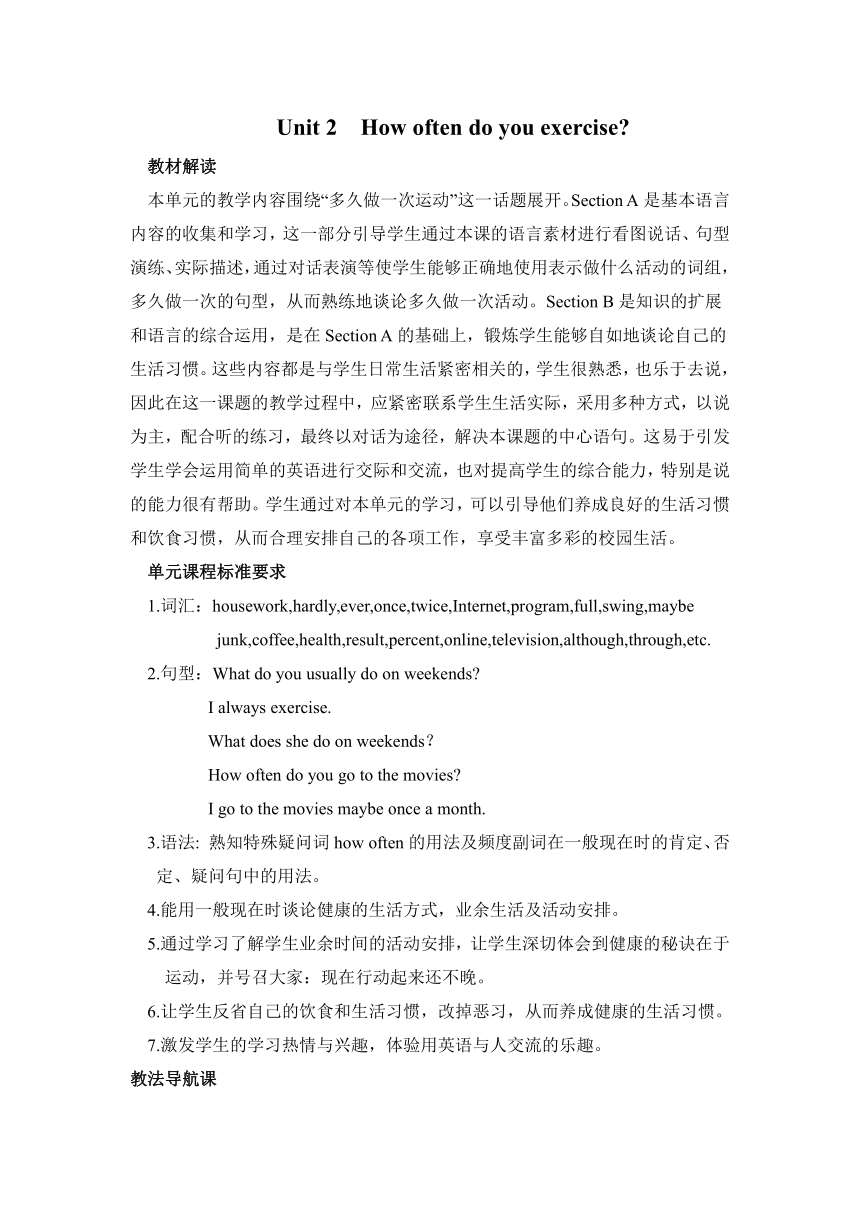 | |
| 格式 | docx | ||
| 文件大小 | 427.1KB | ||
| 资源类型 | 教案 | ||
| 版本资源 | 人教新目标(Go for it)版 | ||
| 科目 | 英语 | ||
| 更新时间 | 2024-06-16 10:17:51 | ||
图片预览

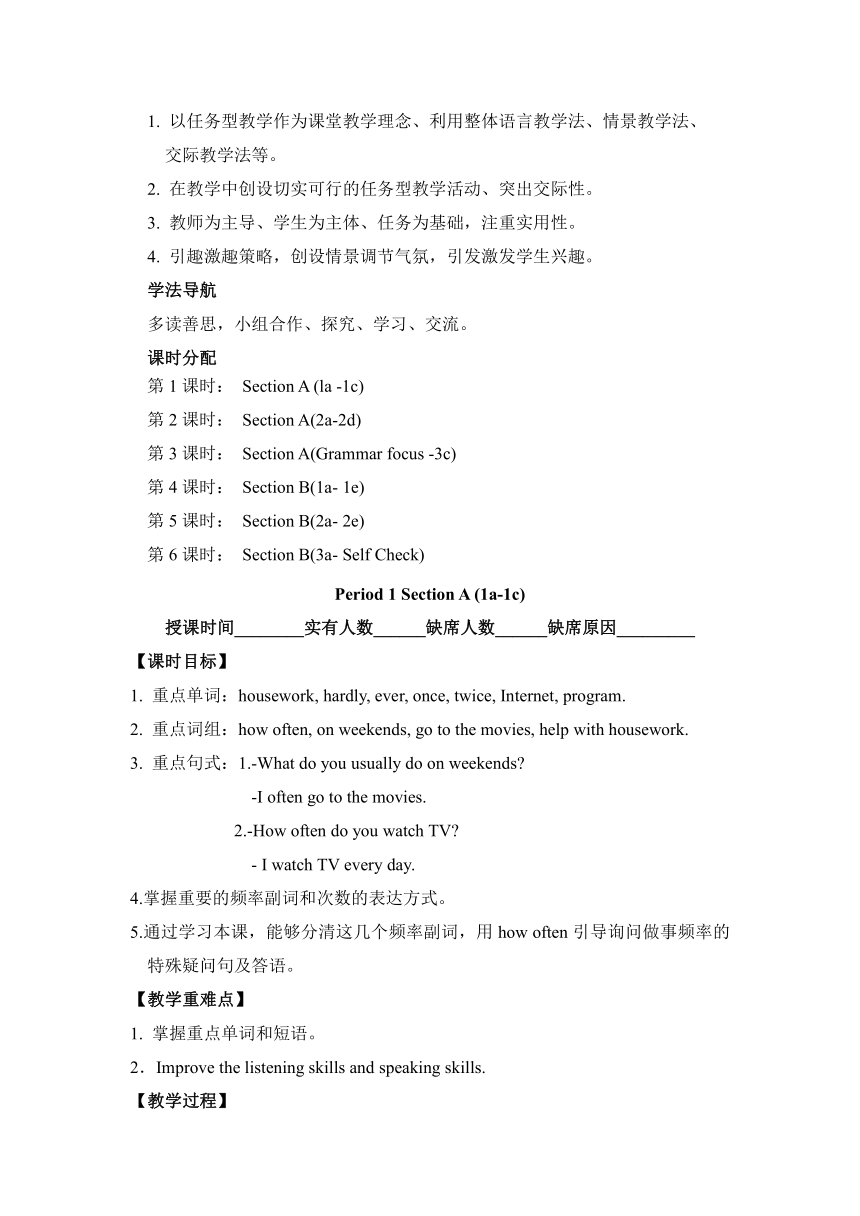
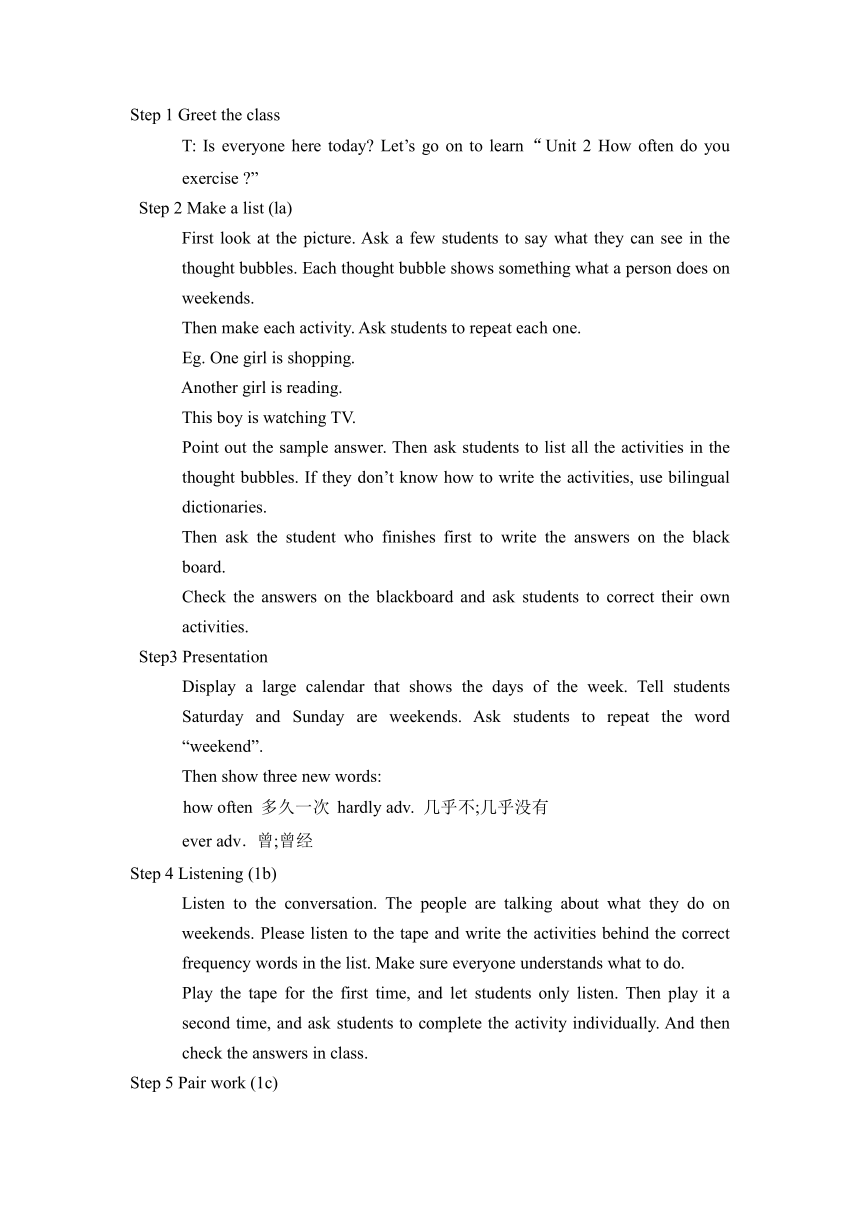
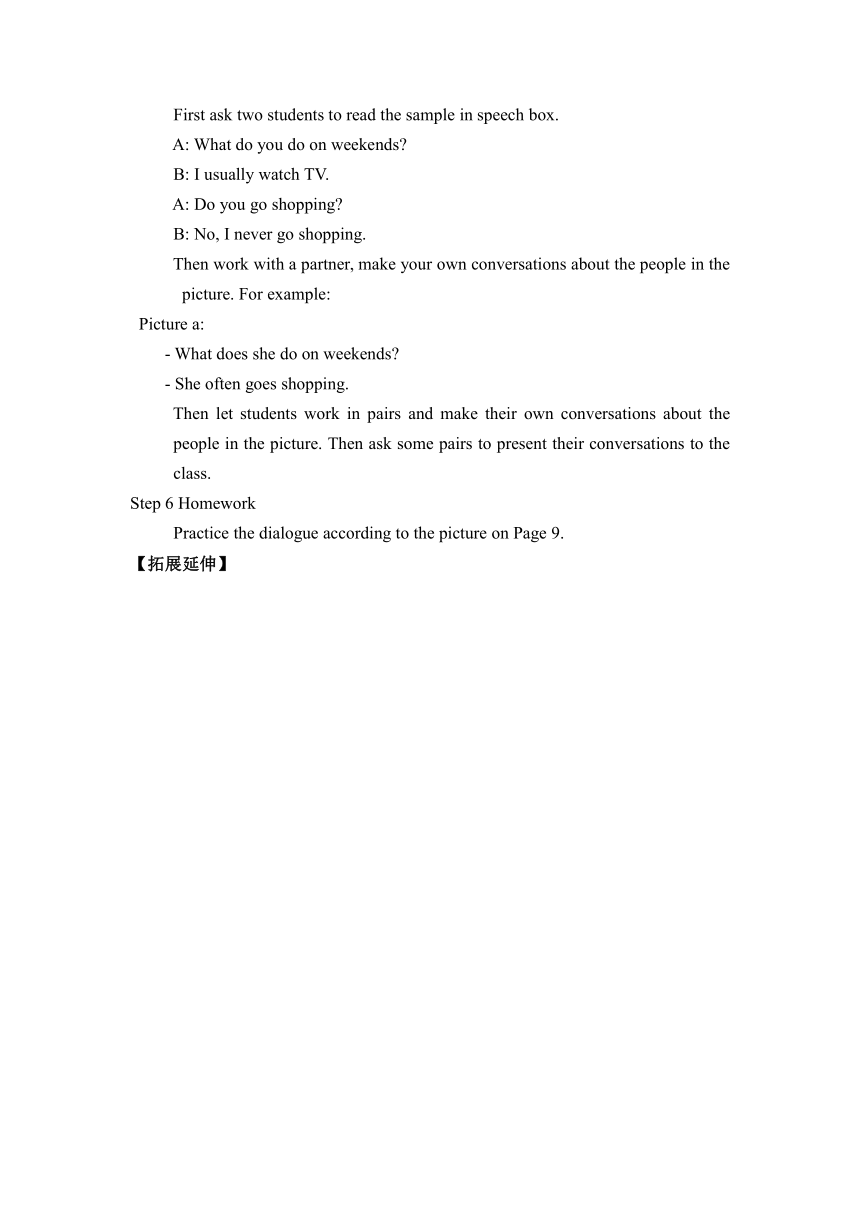
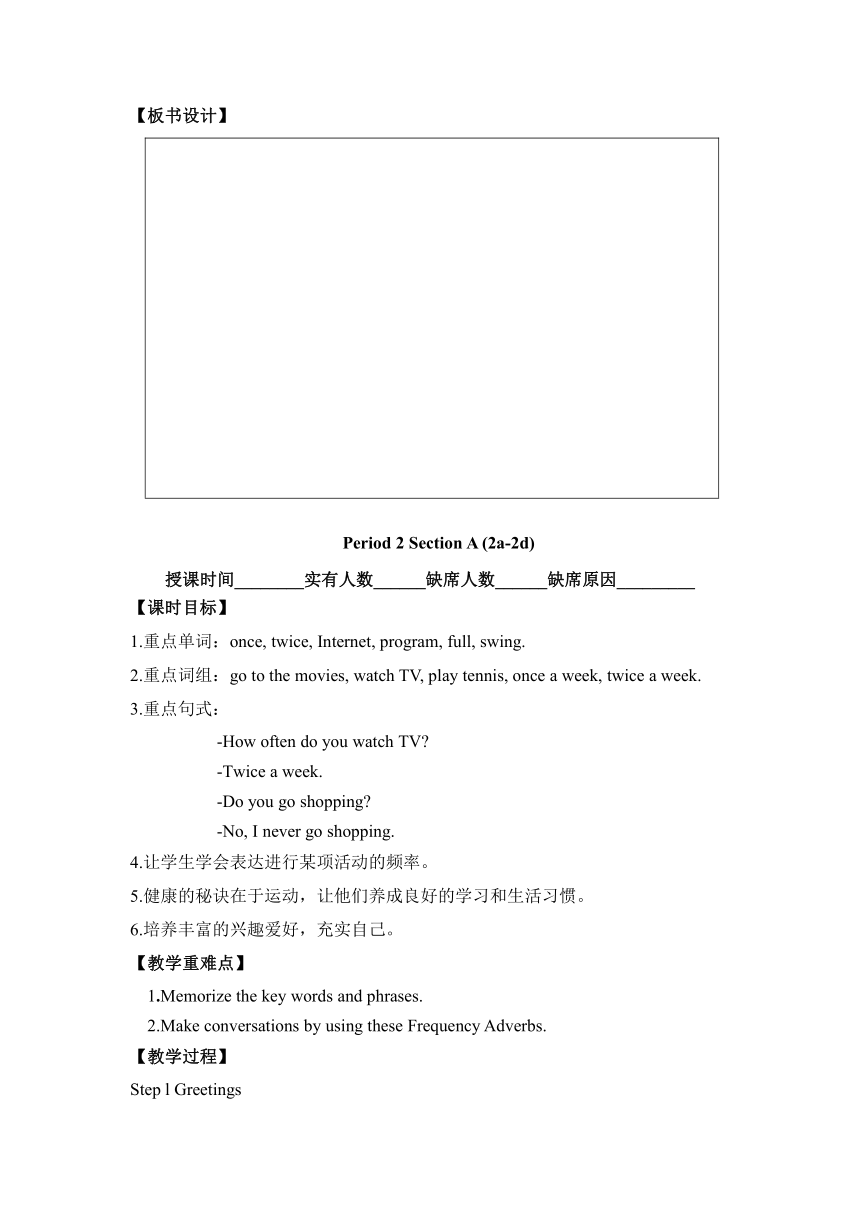
文档简介
Unit 2 How often do you exercise
教材解读
本单元的教学内容围绕“多久做一次运动”这一话题展开。Section A是基本语言内容的收集和学习,这一部分引导学生通过本课的语言素材进行看图说话、句型演练、实际描述,通过对话表演等使学生能够正确地使用表示做什么活动的词组,多久做一次的句型,从而熟练地谈论多久做一次活动。Section B是知识的扩展和语言的综合运用,是在Section A的基础上,锻炼学生能够自如地谈论自己的生活习惯。这些内容都是与学生日常生活紧密相关的,学生很熟悉,也乐于去说,因此在这一课题的教学过程中,应紧密联系学生生活实际,采用多种方式,以说为主,配合听的练习,最终以对话为途径,解决本课题的中心语句。这易于引发学生学会运用简单的英语进行交际和交流,也对提高学生的综合能力,特别是说的能力很有帮助。学生通过对本单元的学习,可以引导他们养成良好的生活习惯和饮食习惯,从而合理安排自己的各项工作,享受丰富多彩的校园生活。
单元课程标准要求
1.词汇:housework,hardly,ever,once,twice,Internet,program,full,swing,maybe
junk,coffee,health,result,percent,online,television,although,through,etc.
2.句型:What do you usually do on weekends
I always exercise.
What does she do on weekends?
How often do you go to the movies
I go to the movies maybe once a month.
3.语法: 熟知特殊疑问词how often的用法及频度副词在一般现在时的肯定、否定、疑问句中的用法。
4.能用一般现在时谈论健康的生活方式,业余生活及活动安排。
5.通过学习了解学生业余时间的活动安排,让学生深切体会到健康的秘诀在于运动,并号召大家:现在行动起来还不晚。
6.让学生反省自己的饮食和生活习惯,改掉恶习,从而养成健康的生活习惯。
7.激发学生的学习热情与兴趣,体验用英语与人交流的乐趣。
教法导航课
以任务型教学作为课堂教学理念、利用整体语言教学法、情景教学法、
交际教学法等。
2. 在教学中创设切实可行的任务型教学活动、突出交际性。
3. 教师为主导、学生为主体、任务为基础,注重实用性。
4. 引趣激趣策略,创设情景调节气氛,引发激发学生兴趣。
学法导航
多读善思,小组合作、探究、学习、交流。
课时分配
第1课时: Section A (la -1c)
第2课时: Section A(2a-2d)
第3课时: Section A(Grammar focus -3c)
第4课时: Section B(1a- 1e)
第5课时: Section B(2a- 2e)
第6课时: Section B(3a- Self Check)
Period 1 Section A (1a-1c)
授课时间________实有人数______缺席人数______缺席原因_________
【课时目标】
重点单词:housework, hardly, ever, once, twice, Internet, program.
重点词组:how often, on weekends, go to the movies, help with housework.
重点句式:1.-What do you usually do on weekends
-I often go to the movies.
2.-How often do you watch TV
- I watch TV every day.
4.掌握重要的频率副词和次数的表达方式。
5.通过学习本课,能够分清这几个频率副词,用how often引导询问做事频率的特殊疑问句及答语。
【教学重难点】
掌握重点单词和短语。
2.Improve the listening skills and speaking skills.
【教学过程】
Step 1 Greet the class
T: Is everyone here today Let’s go on to learn“Unit 2 How often do you exercise ”
Step 2 Make a list (la)
First look at the picture. Ask a few students to say what they can see in the thought bubbles. Each thought bubble shows something what a person does on weekends.
Then make each activity. Ask students to repeat each one.
Eg. One girl is shopping.
Another girl is reading.
This boy is watching TV.
Point out the sample answer. Then ask students to list all the activities in the thought bubbles. If they don’t know how to write the activities, use bilingual dictionaries.
Then ask the student who finishes first to write the answers on the black board.
Check the answers on the blackboard and ask students to correct their own activities.
Step3 Presentation
Display a large calendar that shows the days of the week. Tell students Saturday and Sunday are weekends. Ask students to repeat the word “weekend”.
Then show three new words:
how often 多久一次 hardly adv. 几乎不;几乎没有
ever adv.曾;曾经
Step 4 Listening (1b)
Listen to the conversation. The people are talking about what they do on weekends. Please listen to the tape and write the activities behind the correct frequency words in the list. Make sure everyone understands what to do.
Play the tape for the first time, and let students only listen. Then play it a second time, and ask students to complete the activity individually. And then check the answers in class.
Step 5 Pair work (1c)
First ask two students to read the sample in speech box.
A: What do you do on weekends
B: I usually watch TV.
A: Do you go shopping
B: No, I never go shopping.
Then work with a partner, make your own conversations about the people in the picture. For example:
Picture a:
- What does she do on weekends
- She often goes shopping.
Then let students work in pairs and make their own conversations about the people in the picture. Then ask some pairs to present their conversations to the class.
Step 6 Homework
Practice the dialogue according to the picture on Page 9.
【拓展延伸】
【板书设计】
Period 2 Section A (2a-2d)
授课时间________实有人数______缺席人数______缺席原因_________
【课时目标】
1.重点单词:once, twice, Internet, program, full, swing.
2.重点词组:go to the movies, watch TV, play tennis, once a week, twice a week.
3.重点句式:
-How often do you watch TV
-Twice a week.
-Do you go shopping
-No, I never go shopping.
4.让学生学会表达进行某项活动的频率。
5.健康的秘诀在于运动,让他们养成良好的学习和生活习惯。
6.培养丰富的兴趣爱好,充实自己。
【教学重难点】
1.Memorize the key words and phrases.
2.Make conversations by using these Frequency Adverbs.
【教学过程】
Step l Greetings
Greet the class as usual
Step 2 Revision
Ask the students to look at the picture on Page 9 and make conversations, using
the sentence pattern
-What do you do
-I usually......
-Do you......
-No, I never......
Step 3 Listening (2a and 2b)
1. Introduce some new words: once, twice, three times, program.
Introduce the listening material: This is an interview about what a boy named Cheng Tao usually does. In 2a, listen to the tape and number the activities. For example, what they first talk about is watching TV, so we put the number “1” in front of “watch TV”. Now let’s listen to the tape and number the activities. In 2b, listen again and match the activities. For example, what they first talk about is watching TV, and Cheng Tao’s answer is “... about twice a week ...”, so we match “watching TV” with “Twice a week” with line. Now, let’s listen to the tape and match the activities.
2. Make sure the students understand the listening tasks. Then play the tape and check the answers together.
Step 4 Pair work (2c)
First ask a student to read the list of activities to the class.
watch TV use the Internet read English books
go to the movies exercise
Then check if all the students understand the vocabulary and phrases. The teacher can say, “Now tell me how often you do these activities .” Fill in the chart and then make conversations. Ask two of the students to act out the conversation like 2c.
Step 5 Role-play
Role-play the conversation.
First ask two students to act out the conversation, and then make their own conversations. It can help them to improve their oral English and speaking skills .
Step 6 Summary
This class we’ve learnt some frequency words, such as every day, once a week, twice a week, three times a week, once a month, twice a month. And we’ve learnt to talk about how often people do things. After class do more practice and keep a diary. And remember to exercise every day. It can help you to build up your strong body and keep fit.
Step 7 Homework
1.Finish the exercises in workbook.
2.Recite 2c and make a similar conversation with your partner.
【拓展延伸】
【板书设计】
Period 3 Section A (Grammar Focus—3c)
授课时间________实有人数______缺席人数______缺席原因_________
【课时目标】
1.重点单词: maybe, least, exercise, full, swing.
2.重点词组: watch TV, at least, go shopping.
3.重点句式: -How often do you ...
-What do you usually do on weekends
-Do you go shopping
-No, I never go shopping.
巩固一般现在时的肯定, 否定及疑问句式。
5.熟练运用how often及其答语。
6.学会表达他们的日常活动,热爱生活。
【教学重难点】
学会用how often 提问,并使用正确的答语回复。
激发学生兴趣,使他们运用所学知识谈论业余活动。
【教学过程】
Step 1 Revision
Talk about students’ daily activities.
Step 2 Leading in
First ask students what they usually do if they are free. And talk about their daily life.
Step 3 Grammar focus
Read the sentences together, and then help students to summarize the grammar.
T:This period we've learnt some frequency words, such as every day, once a week, twice a week, three times a week, once a month, twice a month, always, often, sometimes, hardly ever, never...
Step 4 Fill in the blanks (3a)
First show some sentences, and then ask students to fill in the blanks with do or does. For example:
1.-How often ______ your sister watch TV -She watches TV every day.
2.-______ you exercise every day -Yes, I _.
3.-____ your parents play sports -Yes, they .
Complete the questions with do or does in 3a.Then match the questions and answers.
This step helps students know when to use do or does.
Step3 Pair work (3b)
Use the words given to write questions. Then ask and answer them with a partner.
Step4 Pair work (3c)
What can you do to improve your English Add more things to the chart.
Then ask your classmates the questions and find the best student.
A: How often do you read English books
B: I read English books about twice a week.
【拓展与延伸】
【板书设计】
Period 4 Section B (1a—1e)
授课时间________实有人数______缺席人数______缺席原因_________
【课时目标】
1.重点单词: junk food, coffee, health.
2.重点句式: How often do you drink milk
I drink milk every day.
3.Practice listening skills.
4.Tell the students to form good eating habits and exercise more.
5.谈论饮食习惯,增进友谊。
【教学重难点】
“How often” cause of special questions and answers.
用英语描写自己的饮食习惯
【教学过程】
Step 1 Leading in
1.Greetings& free talk.
2.Practice reading the conversation on Page 10.
3.Check the homework.
Step 2 Match the pictures (la)
Point at the words. Let students read after the teacher. Make sure the students understand what their meanings are.
Let students pay attention to the pictures. Say something about the pictures. Match the words with the pictures. Check the answers and then practice reading.
Step 3 Ask and answer (1b)
Pair work:
T: Now look at the conversation in 1b. I’ll ask two students to read it to the class.
Work with your partner. Please make your own conversations using the words in la. For example:
A: How often do you eat vegetables
B: I eat vegetables every day.
A: Do you like it
B: No. But my mother wants me to eat it. She says it is good for my health.
Then ask some pairs to present their conversations to the class.
Step 4 Listening (1c&1d)
1c
T: Now you will hear a reporter interviewing two people, Tina and Bill. Read the two names for the student. In 1c. we’ll know who is healthy, Bill or Tina Read the questions in 1c. Listen to the tape carefully twice. Circle “Yes”, “No” or “I don’t know” in the chart.
1d
1.Before we check the answers in lc, we’ll read through the questions in 1d. Pay attention to Tina’s and Bill’s answers.
2.From the answers in 1d, ask the question: Who is healthy, Bill or Tina
Step 5 Pair work (le)
Student A is the reporter. Student B is Tina or Bill. Ask and answer questions. Then change roles.
A: How often do you exercise
B: I exercise every day.
A: And how often do you......
Step 6 Homework
Writing: My Eating Habit
【拓展与延伸】
【板书设计】
Period 5 Section B (2a—2e)
授课时间________实有人数______缺席人数______缺席原因_________
【课时目标】
1.重点单词:result, percent, online, although, through, mind, body, such.
2.重点词组:such as, go to the movies, play computers, use the Internet.
3.重点句式: Here are the results.
Most students use it for fun and not for homework.
The answers to our questions about watching television were also interesting.
4.能够准确的用表示频率的词组来描述做事情的频率。
5.教会学生合理的分配时间,劳逸结合。
6培养学生的阅读理解能力,提高辨别是非的能力。
【教学重难点】
Learn to write a passage like 2b.
【教学过程】
Step 1 Leading - in
Greet the class and check the homework.
Step 2 Presentation
Show the new words on the screen and teach students to read them. And ask them to repeat.
Step 3 Rank these activities (2a)
Read the phrases, and ask students to repeat and translate them. Make sure the students can read and understand the phrases.
Rank these activities according to how often you think your classmates do them (1= most often ,6= least often).
Step 4 Reading (2b)
Explain the reading task.
T: Now please open your books on page 13. Look at 2b first, and I’ll read each line of the article to you.
This article shows what No.5 High School students do in their free time: how often they exercise, how often they use the Internet and how often they watch TV.
Read the article sentence by sentence and then translate into Chinese.
Step 5 Questions and answers (2c)
Read the article again and answer the questions.
1.How many percent of the students do not exercise at all
2.How many percent of the students use the Internet every day
3.How often do most students watch TV What do they usually watch
4.What does the writer think is the best way to relax Why
5.Do you think the students at No .5 High School are healthy Why or why not
Help the students to answer these questions.
Step 6 Writing (2d)
According to the article and the pie charts, write sentences with the percentages using always, usually or sometimes.
Keys:
1.90%:
2.85%:
3.45%:
4.10%:
5.13%:
6.2%:
This step helps students make sentences according to the article and understand it clearly.
Step 7 Group work (2e)
Free talk:
Choose one of these free time activities or think of your own Then ask your classmates how often they do this activity and make a pie chart. Show the pie chart to your class.
Step 8 Homework
Recite the article.
【拓展延伸】
【板书设计】
Period 6 Section B (3a—Self Check)
授课时间________实有人数______缺席人数______缺席原因_________
【课时目标】
1.重点单词: dentist, magazine, however, than, almost, none, less, point.
2.重点句式: ①Jane is a 16-year-old high school student in the United
States.
②She says she is afraid!
③You have to learn more about healthy habits.
3.重点短语:do exercise, read books, help with housework, go to the dentist.
watch TV for over 2 hours, eat hamburgers, stay up late.
4.用一般现在时,叙述自己的饮食习惯。
【教学重难点】
用英语描写自己的好的、坏的饮食习惯
【教学过程】
Step 1 Revision
Ask several students to retell the article in their own words
Step 2 Complete the report(3a)
Look at the information in the chart and complete the report. The teacher reads the passage, and asks students to fill in the blanks with the proper words. Discuss what are good and what are bad habits.
Step 3 Complete the chart (3b)
Complete the chart with your own information. In the last column, use expressions like always, every day, twice a week and never.
Step 4 Writing(3c)
Write a report about your good and bad habits. Say how often you do things.
Use the report in 3a as an example.
Step 5 Homework
Give advice on what good habits are.
话题分析
本单元的作文是用“主语+活动+频率”写日常活动。
常用句型
She has a lot of good habits.
However, she has some bad habits, too.
I exercise every day.
She hardly ever stays up late.
It’s good for my health.
She usually watches TV for more than two hours a day.
写作实例
假设你叫李华,你们市将要举行以“How to Eat in a Healthy Way”为题的演讲比赛,请你写一篇演讲稿,内容包括:
1.说明演讲的主题(how to eat in a healthy way);
2.我们应该少吃及多吃的食物有哪些,并说明原因;
3.描述自己的健康饮食习惯,并举例说明;
【写前指导】
【教学反思】
教材解读
本单元的教学内容围绕“多久做一次运动”这一话题展开。Section A是基本语言内容的收集和学习,这一部分引导学生通过本课的语言素材进行看图说话、句型演练、实际描述,通过对话表演等使学生能够正确地使用表示做什么活动的词组,多久做一次的句型,从而熟练地谈论多久做一次活动。Section B是知识的扩展和语言的综合运用,是在Section A的基础上,锻炼学生能够自如地谈论自己的生活习惯。这些内容都是与学生日常生活紧密相关的,学生很熟悉,也乐于去说,因此在这一课题的教学过程中,应紧密联系学生生活实际,采用多种方式,以说为主,配合听的练习,最终以对话为途径,解决本课题的中心语句。这易于引发学生学会运用简单的英语进行交际和交流,也对提高学生的综合能力,特别是说的能力很有帮助。学生通过对本单元的学习,可以引导他们养成良好的生活习惯和饮食习惯,从而合理安排自己的各项工作,享受丰富多彩的校园生活。
单元课程标准要求
1.词汇:housework,hardly,ever,once,twice,Internet,program,full,swing,maybe
junk,coffee,health,result,percent,online,television,although,through,etc.
2.句型:What do you usually do on weekends
I always exercise.
What does she do on weekends?
How often do you go to the movies
I go to the movies maybe once a month.
3.语法: 熟知特殊疑问词how often的用法及频度副词在一般现在时的肯定、否定、疑问句中的用法。
4.能用一般现在时谈论健康的生活方式,业余生活及活动安排。
5.通过学习了解学生业余时间的活动安排,让学生深切体会到健康的秘诀在于运动,并号召大家:现在行动起来还不晚。
6.让学生反省自己的饮食和生活习惯,改掉恶习,从而养成健康的生活习惯。
7.激发学生的学习热情与兴趣,体验用英语与人交流的乐趣。
教法导航课
以任务型教学作为课堂教学理念、利用整体语言教学法、情景教学法、
交际教学法等。
2. 在教学中创设切实可行的任务型教学活动、突出交际性。
3. 教师为主导、学生为主体、任务为基础,注重实用性。
4. 引趣激趣策略,创设情景调节气氛,引发激发学生兴趣。
学法导航
多读善思,小组合作、探究、学习、交流。
课时分配
第1课时: Section A (la -1c)
第2课时: Section A(2a-2d)
第3课时: Section A(Grammar focus -3c)
第4课时: Section B(1a- 1e)
第5课时: Section B(2a- 2e)
第6课时: Section B(3a- Self Check)
Period 1 Section A (1a-1c)
授课时间________实有人数______缺席人数______缺席原因_________
【课时目标】
重点单词:housework, hardly, ever, once, twice, Internet, program.
重点词组:how often, on weekends, go to the movies, help with housework.
重点句式:1.-What do you usually do on weekends
-I often go to the movies.
2.-How often do you watch TV
- I watch TV every day.
4.掌握重要的频率副词和次数的表达方式。
5.通过学习本课,能够分清这几个频率副词,用how often引导询问做事频率的特殊疑问句及答语。
【教学重难点】
掌握重点单词和短语。
2.Improve the listening skills and speaking skills.
【教学过程】
Step 1 Greet the class
T: Is everyone here today Let’s go on to learn“Unit 2 How often do you exercise ”
Step 2 Make a list (la)
First look at the picture. Ask a few students to say what they can see in the thought bubbles. Each thought bubble shows something what a person does on weekends.
Then make each activity. Ask students to repeat each one.
Eg. One girl is shopping.
Another girl is reading.
This boy is watching TV.
Point out the sample answer. Then ask students to list all the activities in the thought bubbles. If they don’t know how to write the activities, use bilingual dictionaries.
Then ask the student who finishes first to write the answers on the black board.
Check the answers on the blackboard and ask students to correct their own activities.
Step3 Presentation
Display a large calendar that shows the days of the week. Tell students Saturday and Sunday are weekends. Ask students to repeat the word “weekend”.
Then show three new words:
how often 多久一次 hardly adv. 几乎不;几乎没有
ever adv.曾;曾经
Step 4 Listening (1b)
Listen to the conversation. The people are talking about what they do on weekends. Please listen to the tape and write the activities behind the correct frequency words in the list. Make sure everyone understands what to do.
Play the tape for the first time, and let students only listen. Then play it a second time, and ask students to complete the activity individually. And then check the answers in class.
Step 5 Pair work (1c)
First ask two students to read the sample in speech box.
A: What do you do on weekends
B: I usually watch TV.
A: Do you go shopping
B: No, I never go shopping.
Then work with a partner, make your own conversations about the people in the picture. For example:
Picture a:
- What does she do on weekends
- She often goes shopping.
Then let students work in pairs and make their own conversations about the people in the picture. Then ask some pairs to present their conversations to the class.
Step 6 Homework
Practice the dialogue according to the picture on Page 9.
【拓展延伸】
【板书设计】
Period 2 Section A (2a-2d)
授课时间________实有人数______缺席人数______缺席原因_________
【课时目标】
1.重点单词:once, twice, Internet, program, full, swing.
2.重点词组:go to the movies, watch TV, play tennis, once a week, twice a week.
3.重点句式:
-How often do you watch TV
-Twice a week.
-Do you go shopping
-No, I never go shopping.
4.让学生学会表达进行某项活动的频率。
5.健康的秘诀在于运动,让他们养成良好的学习和生活习惯。
6.培养丰富的兴趣爱好,充实自己。
【教学重难点】
1.Memorize the key words and phrases.
2.Make conversations by using these Frequency Adverbs.
【教学过程】
Step l Greetings
Greet the class as usual
Step 2 Revision
Ask the students to look at the picture on Page 9 and make conversations, using
the sentence pattern
-What do you do
-I usually......
-Do you......
-No, I never......
Step 3 Listening (2a and 2b)
1. Introduce some new words: once, twice, three times, program.
Introduce the listening material: This is an interview about what a boy named Cheng Tao usually does. In 2a, listen to the tape and number the activities. For example, what they first talk about is watching TV, so we put the number “1” in front of “watch TV”. Now let’s listen to the tape and number the activities. In 2b, listen again and match the activities. For example, what they first talk about is watching TV, and Cheng Tao’s answer is “... about twice a week ...”, so we match “watching TV” with “Twice a week” with line. Now, let’s listen to the tape and match the activities.
2. Make sure the students understand the listening tasks. Then play the tape and check the answers together.
Step 4 Pair work (2c)
First ask a student to read the list of activities to the class.
watch TV use the Internet read English books
go to the movies exercise
Then check if all the students understand the vocabulary and phrases. The teacher can say, “Now tell me how often you do these activities .” Fill in the chart and then make conversations. Ask two of the students to act out the conversation like 2c.
Step 5 Role-play
Role-play the conversation.
First ask two students to act out the conversation, and then make their own conversations. It can help them to improve their oral English and speaking skills .
Step 6 Summary
This class we’ve learnt some frequency words, such as every day, once a week, twice a week, three times a week, once a month, twice a month. And we’ve learnt to talk about how often people do things. After class do more practice and keep a diary. And remember to exercise every day. It can help you to build up your strong body and keep fit.
Step 7 Homework
1.Finish the exercises in workbook.
2.Recite 2c and make a similar conversation with your partner.
【拓展延伸】
【板书设计】
Period 3 Section A (Grammar Focus—3c)
授课时间________实有人数______缺席人数______缺席原因_________
【课时目标】
1.重点单词: maybe, least, exercise, full, swing.
2.重点词组: watch TV, at least, go shopping.
3.重点句式: -How often do you ...
-What do you usually do on weekends
-Do you go shopping
-No, I never go shopping.
巩固一般现在时的肯定, 否定及疑问句式。
5.熟练运用how often及其答语。
6.学会表达他们的日常活动,热爱生活。
【教学重难点】
学会用how often 提问,并使用正确的答语回复。
激发学生兴趣,使他们运用所学知识谈论业余活动。
【教学过程】
Step 1 Revision
Talk about students’ daily activities.
Step 2 Leading in
First ask students what they usually do if they are free. And talk about their daily life.
Step 3 Grammar focus
Read the sentences together, and then help students to summarize the grammar.
T:This period we've learnt some frequency words, such as every day, once a week, twice a week, three times a week, once a month, twice a month, always, often, sometimes, hardly ever, never...
Step 4 Fill in the blanks (3a)
First show some sentences, and then ask students to fill in the blanks with do or does. For example:
1.-How often ______ your sister watch TV -She watches TV every day.
2.-______ you exercise every day -Yes, I _.
3.-____ your parents play sports -Yes, they .
Complete the questions with do or does in 3a.Then match the questions and answers.
This step helps students know when to use do or does.
Step3 Pair work (3b)
Use the words given to write questions. Then ask and answer them with a partner.
Step4 Pair work (3c)
What can you do to improve your English Add more things to the chart.
Then ask your classmates the questions and find the best student.
A: How often do you read English books
B: I read English books about twice a week.
【拓展与延伸】
【板书设计】
Period 4 Section B (1a—1e)
授课时间________实有人数______缺席人数______缺席原因_________
【课时目标】
1.重点单词: junk food, coffee, health.
2.重点句式: How often do you drink milk
I drink milk every day.
3.Practice listening skills.
4.Tell the students to form good eating habits and exercise more.
5.谈论饮食习惯,增进友谊。
【教学重难点】
“How often” cause of special questions and answers.
用英语描写自己的饮食习惯
【教学过程】
Step 1 Leading in
1.Greetings& free talk.
2.Practice reading the conversation on Page 10.
3.Check the homework.
Step 2 Match the pictures (la)
Point at the words. Let students read after the teacher. Make sure the students understand what their meanings are.
Let students pay attention to the pictures. Say something about the pictures. Match the words with the pictures. Check the answers and then practice reading.
Step 3 Ask and answer (1b)
Pair work:
T: Now look at the conversation in 1b. I’ll ask two students to read it to the class.
Work with your partner. Please make your own conversations using the words in la. For example:
A: How often do you eat vegetables
B: I eat vegetables every day.
A: Do you like it
B: No. But my mother wants me to eat it. She says it is good for my health.
Then ask some pairs to present their conversations to the class.
Step 4 Listening (1c&1d)
1c
T: Now you will hear a reporter interviewing two people, Tina and Bill. Read the two names for the student. In 1c. we’ll know who is healthy, Bill or Tina Read the questions in 1c. Listen to the tape carefully twice. Circle “Yes”, “No” or “I don’t know” in the chart.
1d
1.Before we check the answers in lc, we’ll read through the questions in 1d. Pay attention to Tina’s and Bill’s answers.
2.From the answers in 1d, ask the question: Who is healthy, Bill or Tina
Step 5 Pair work (le)
Student A is the reporter. Student B is Tina or Bill. Ask and answer questions. Then change roles.
A: How often do you exercise
B: I exercise every day.
A: And how often do you......
Step 6 Homework
Writing: My Eating Habit
【拓展与延伸】
【板书设计】
Period 5 Section B (2a—2e)
授课时间________实有人数______缺席人数______缺席原因_________
【课时目标】
1.重点单词:result, percent, online, although, through, mind, body, such.
2.重点词组:such as, go to the movies, play computers, use the Internet.
3.重点句式: Here are the results.
Most students use it for fun and not for homework.
The answers to our questions about watching television were also interesting.
4.能够准确的用表示频率的词组来描述做事情的频率。
5.教会学生合理的分配时间,劳逸结合。
6培养学生的阅读理解能力,提高辨别是非的能力。
【教学重难点】
Learn to write a passage like 2b.
【教学过程】
Step 1 Leading - in
Greet the class and check the homework.
Step 2 Presentation
Show the new words on the screen and teach students to read them. And ask them to repeat.
Step 3 Rank these activities (2a)
Read the phrases, and ask students to repeat and translate them. Make sure the students can read and understand the phrases.
Rank these activities according to how often you think your classmates do them (1= most often ,6= least often).
Step 4 Reading (2b)
Explain the reading task.
T: Now please open your books on page 13. Look at 2b first, and I’ll read each line of the article to you.
This article shows what No.5 High School students do in their free time: how often they exercise, how often they use the Internet and how often they watch TV.
Read the article sentence by sentence and then translate into Chinese.
Step 5 Questions and answers (2c)
Read the article again and answer the questions.
1.How many percent of the students do not exercise at all
2.How many percent of the students use the Internet every day
3.How often do most students watch TV What do they usually watch
4.What does the writer think is the best way to relax Why
5.Do you think the students at No .5 High School are healthy Why or why not
Help the students to answer these questions.
Step 6 Writing (2d)
According to the article and the pie charts, write sentences with the percentages using always, usually or sometimes.
Keys:
1.90%:
2.85%:
3.45%:
4.10%:
5.13%:
6.2%:
This step helps students make sentences according to the article and understand it clearly.
Step 7 Group work (2e)
Free talk:
Choose one of these free time activities or think of your own Then ask your classmates how often they do this activity and make a pie chart. Show the pie chart to your class.
Step 8 Homework
Recite the article.
【拓展延伸】
【板书设计】
Period 6 Section B (3a—Self Check)
授课时间________实有人数______缺席人数______缺席原因_________
【课时目标】
1.重点单词: dentist, magazine, however, than, almost, none, less, point.
2.重点句式: ①Jane is a 16-year-old high school student in the United
States.
②She says she is afraid!
③You have to learn more about healthy habits.
3.重点短语:do exercise, read books, help with housework, go to the dentist.
watch TV for over 2 hours, eat hamburgers, stay up late.
4.用一般现在时,叙述自己的饮食习惯。
【教学重难点】
用英语描写自己的好的、坏的饮食习惯
【教学过程】
Step 1 Revision
Ask several students to retell the article in their own words
Step 2 Complete the report(3a)
Look at the information in the chart and complete the report. The teacher reads the passage, and asks students to fill in the blanks with the proper words. Discuss what are good and what are bad habits.
Step 3 Complete the chart (3b)
Complete the chart with your own information. In the last column, use expressions like always, every day, twice a week and never.
Step 4 Writing(3c)
Write a report about your good and bad habits. Say how often you do things.
Use the report in 3a as an example.
Step 5 Homework
Give advice on what good habits are.
话题分析
本单元的作文是用“主语+活动+频率”写日常活动。
常用句型
She has a lot of good habits.
However, she has some bad habits, too.
I exercise every day.
She hardly ever stays up late.
It’s good for my health.
She usually watches TV for more than two hours a day.
写作实例
假设你叫李华,你们市将要举行以“How to Eat in a Healthy Way”为题的演讲比赛,请你写一篇演讲稿,内容包括:
1.说明演讲的主题(how to eat in a healthy way);
2.我们应该少吃及多吃的食物有哪些,并说明原因;
3.描述自己的健康饮食习惯,并举例说明;
【写前指导】
【教学反思】
同课章节目录
- Unit 1 Where did you go on vacation?
- Section A
- Section B
- Unit 2 How often do you exercise?
- Section A
- Section B
- Unit 3 I'm more outgoing than my sister.
- Section A
- Section B
- Unit 4 What's the best movie theater?
- Section A
- Section B
- Unit 5 Do you want to watch a game show?
- Section A
- Section B
- Unit 6 I'm going to study computer science.
- Section A
- Section B
- Unit 7 Will people have robots?
- Section A
- Section B
- Unit 8 How do you make a banana milk shake?
- Section A
- Section B
- Unit 9 Can you come to my party?
- Section A
- Section B
- Unit 10 If you go to the party, you'll have a grea
- Section A
- Section B
